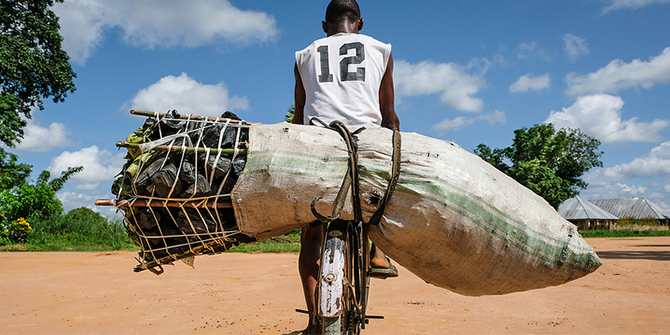Adeline Pelletier looks at the policy implications of internal capital markets among multinational banks.
It is well-documented that global banks contribute to international shock transmission via cross border lending. But global banking has taken another form over the recent decades with the expansion of banks abroad via branches and subsidiaries, especially the expansion from and to developing and emerging economies, as countries have opened up their banking sector to foreign investors (Claessens and van Horen, 2012). Multinational banks operate internal capital markets through which they (re-)allocate capital between their headquarters and their different foreign affiliates in response to financial or real economic shocks. In developing countries where interbank and capital markets are underdeveloped and a large part of the population is unbanked, the ability to receive funding through internal capital markets at low cost and in large quantity might present a significant advantage for foreign banks’ affiliates. However, as internal funding reallocation can alter the funding position of a bank’s affiliate, this may in turn lead to adjustments in foreign affiliates lending in their host market, thus creating another channel of international transmission of shocks (Cetorelli and Goldberg, 2012).

Impact of a financial crisis on capital re-allocation inside banking groups
In a recent academic study, I explore this issue by using a novel database on banks operating in South Africa which includes information on internal loans and deposits from and to the banking group. Exploring the impact of the 1997 East Asian Crisis on capital re-allocation inside banks, I found that South African affiliates belonging to banking groups with high exposure to East Asian Crisis countries (in terms of total banking assets of the group in crisis countries) experienced a significant drop in their net internal funding position during the crisis, relative to South African affiliates of less exposed groups. The South African foreign affiliates of highly exposed multinational banks both received less internal funding from their group during the East Asian Crisis period than before, and lent more to their group, relative to the affiliates of less exposed groups. This result suggests that parent banks of more exposed groups reallocated capital away from South Africa to support their affiliates in East Asia.
Exploring the link between internal capital funding and domestic lending
Do foreign affiliates that receive internal capital from their group expand their local bank credit? Using an instrumental variable technique I found that a 10% increase in the outstanding volume of internal funding resulted in a 5.6% increase in the volume of mortgage advances. As such, foreign affiliates do not only use this extra capital to acquire government securities or to invest abroad, as it has been reported in Africa where banks are often highly liquid but lend relatively little domestically (see Beck, Maimbo, Faye and Triki, 2011). They also “pass it on’’ to the local economy by expanding their domestic lending.
Policy implications
This study suggests that foreign affiliates have ambiguous effects for the financial stability of the host country. On the one hand, being part of a foreign group reduces the risk of bankruptcy of foreign affiliates by allowing for the reception of internal capital from the group.
On the other hand, internal capital markets are a channel through which financial crises are transmitted from one country to another, when abrupt capital reallocations inside the group take place. However, the strength of this channel will partly depend on the legal structure of the foreign affiliate. Indeed, the organisational form of the foreign affiliate, either as a branch or as a subsidiary will have an impact on the stability of the banking sector and the local supply of credit through the internal capital market channel, as branches are more integrated to their group via this channel than subsidiaries.
A potential policy implication of this research for bank regulators may be that favouring the organisation of foreign affiliates as subsidiaries rather than branches, through specific banking regulations, may reduce the potential transmission of foreign crises via internal capital markets. One caveat, however, is that if a banking crisis occurs in the host country a parent is fully responsible for all losses incurred under a branch structure, while its obligations are only limited to the value of the invested equity under a subsidiary structure, which makes it more likely to walk away from the operation (Cerrutti et al., 2007; Fiechter et al., 2011). That said, if a foreign affiliate has systemic importance for the health of the banking group, its parent is more likely to support it through transfers of internal liquidity, regardless of its organisational form.
This blogpost is based on the academic paper: Internal capital market practices of multinational banks Evidence from South Africa.
Dr Adeline Pelletier is Assistant Professor of Finance at Instituto de Empresa in Madrid. This research was conducted during her PhD studies at the London School of Economics and Political Science.
Bibliography:
Beck, Thorsten, Samuel Maimbo, Issa Faye, and Thouraya Triki. 2011. Financing Africa: Through the crisis and beyond. Washington DC: World Bank.
Cerutti, Eugenio, Giovanni Dell’Ariccia, and Maria Soledad Martinez Peria. 2007. “How banks go abroad: Branches or subsidiaries?” Journal of Banking and Finance 31 (6):1669-1692.
Cetorelli, Nicola and Linda S. Goldberg. 2012. “Liquidity management of U.S. global banks: Internal
capital markets in the great recession.” Journal of International Economics 88 (2):299-311.
Claessens, Stijn and Neeltje Van Horen. 2012. “Foreign Banks: Trends, Impact and Financial Stability.” Working Paper WP/12/10, IMF.
Fiechter, Jonathan, Inci Otker-Robe, Anna Ilyina, Hsu Michael, Andre Santos, and Jay Surti. 2011. “Subsidiaries or Branches: Does One Size Fit All?” IMF Staff Discussion Note SDN/11/0, IMF.
The views expressed in this post are those of the authors and in no way reflect those of the Africa at LSE blog or the London School of Economics and Political Science.





